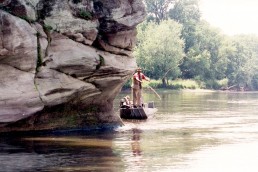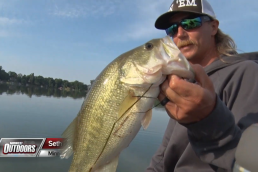Summer Fishing on the North Section of the Rock River
SHARE THIS POST
The 155 miles of Rock River that flows through Illinois from the Wisconsin state line to near Rock Island on the Mississippi River is home to three basic habitats for fish: tailwaters below dams, lakes or sloughs above dams, and the main channel or side channels.
The river varies in width from 500 to 800 feet with an average of 690 feet. The bottom structure is interspersed with sand, rubble and silt.
Generally, the main river channel averages about 15 feet in depth, but between Dixon and Sterling may go down to 50 feet.
The current and depth of the river were significantly altered by the construction of channel dams creating pools throughout most the Illinois section of the river. Drainages ditches and field tiles have converted vast wetlands that once covered major portions of the Rock River basin to cropland.
A very comprehensive booklet on Fishing the Rock is available from the Illinois Department of Natural Resources offices in the area or online at dnr.illinois.gov.
Below each of the eight dams, the tailwaters are accessible for fishing at Rockton, Rockford Fordham, Oregon, Dixon, Sterling, Rock Falls, Milan and Rock Island.
The various parks, both state and local, also have boat launches and bank fishing with most having handicap-accessible piers. The water is usually rough and turbulent due to the flow over the dam. Fish congregate in the oxygen-rich water.
The deep, swift water of channels lacks structure other than large rocks and deep holes. Between the main channel and the side channel is that part of the river containing debris and stumps.
Above the dams are lakes and sloughs with slow-running water. The oxygen level is lower there and the fishing is usually not as good.
Traveling further south, the river widens, and as a result it is often rather shallow. The water flow slows as the river passes through some of Illinois’ most scenic landscapes, wilderness areas as well as urban areas. The shallows still have deep holes where fish seek refuge from the summer heat. They are often the home of some big catfish.
Are you enjoying this post?
You can be among the first to get the latest info on where to go, what to use and how to use it!
The best multi-species fishing locations seem to begin at the Oregon Dam. The river yields such diverse species of fish as northern pike, walleyes, bluegills, white bass, smallmouth and largemouth bass. It is renowned for the ample population of channel and flathead catfish.
There are several boat launch areas on the western side of the river in Castle Rock State Park and on the eastern side at Lowden State Park.
Both of the catfish species are the most abundant of the fish present. Channel catfish are found near fallen trees, stumps and around log jams. The big flatheads hang out in deep holes like the one in the tailwater below the Oregon dam. Anglers ply the upstream lip of that hole, as it is a good place to find fish at night. Flatheads like deep water, and as a result they tend to be found in or near the main river channel. If you can find a big, fallen tree in an area with plenty of deep water, chances are that it will yield a flathead or two.
Channel cats tend to bite better at night and they can be caught from the bank using minnows. Often anglers fishing after dark will catch fish that come to the top to feed. Baits should be placed just under the surface as night approaches. Locally, stink baits and blood baits as well as cut bait and chicken livers are popular.
The smallmouth action in this part of the river begins to heat up once the water warms to 60 degrees and continues through the summer into early fall. Fish are found in just about any rocky area, especially from the dam at Oregon south. The island in the tailrace is the beginning of the deep water. Smallmouths like the deeper water in summer. The western bank of the river is a good bet from the dam on down the river for quite a long way. From about 10 feet of the south end of the island, the water drops away to about a 20-foot depth. Anglers work close to the rocky structure. Smallmouths hang very close to the rocks. Most smallies are taken on a jig head with some kind of live bait attached.
The smallmouth fishery is rated as very good by the IDNR. Smallies are abundant in the river according to local fisheries biologists. In their surveys, they find fish over 18 inches in length near Prophetstown and Grand Tour. Other good areas are at the dams in Rockford, Dixon and Oregon in the northern part of the river.
In an effort to establish a sport fishery, the IDNR stocks walleyes each year. Good fishing is found in the waters of the Rock above the Oregon Dam and the Pecatonica River, a feeder to the Rock. The best fishing success by anglers seems to come in the Rock River north of Rockford. Some success is also available near Dixon and at Prophetstown State Park. Fish up to 5.5 pounds have been caught up to this time.
Camping and picnic areas are available in the state parks. The various towns and cities along the rivers course also have motels and cabins available.
“Fishing the Rock” is a great idea from now until the snowfall in the beginning of winter.
MWO
SHARE THIS POST
Did you enjoy this post?
You can be among the first to get the latest info on where to go, what to use and how to use it!
Don Gasaway
Don Gasaway is a veteran freelance outdoor writer from Marion, Ill. He may also be found at: https://www.facebook.com/DonGasawayWriter and facebook.com/Wandering Angler. Comments are welcome




